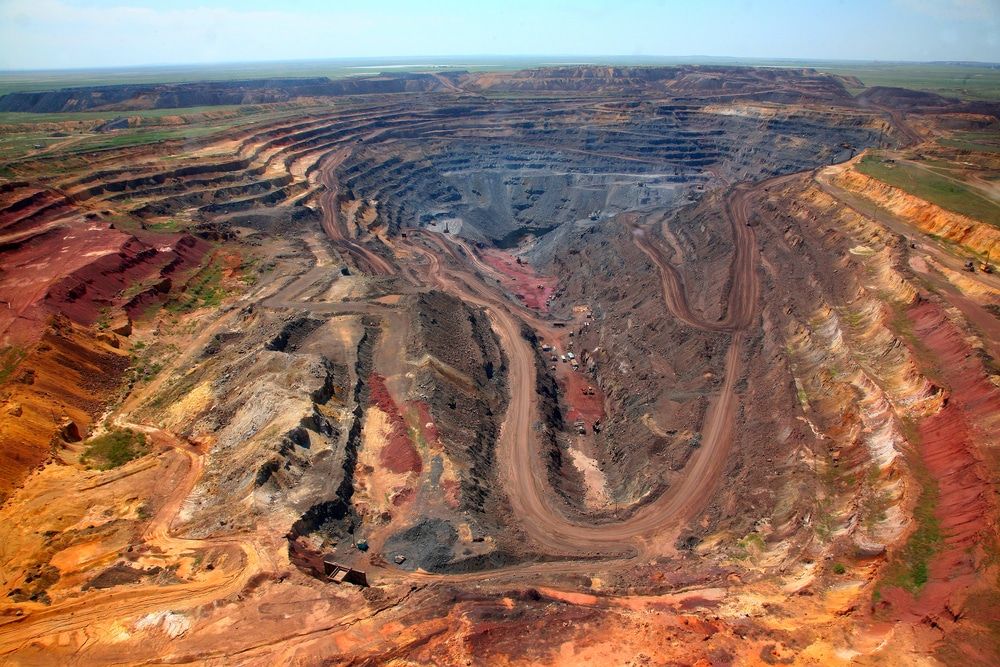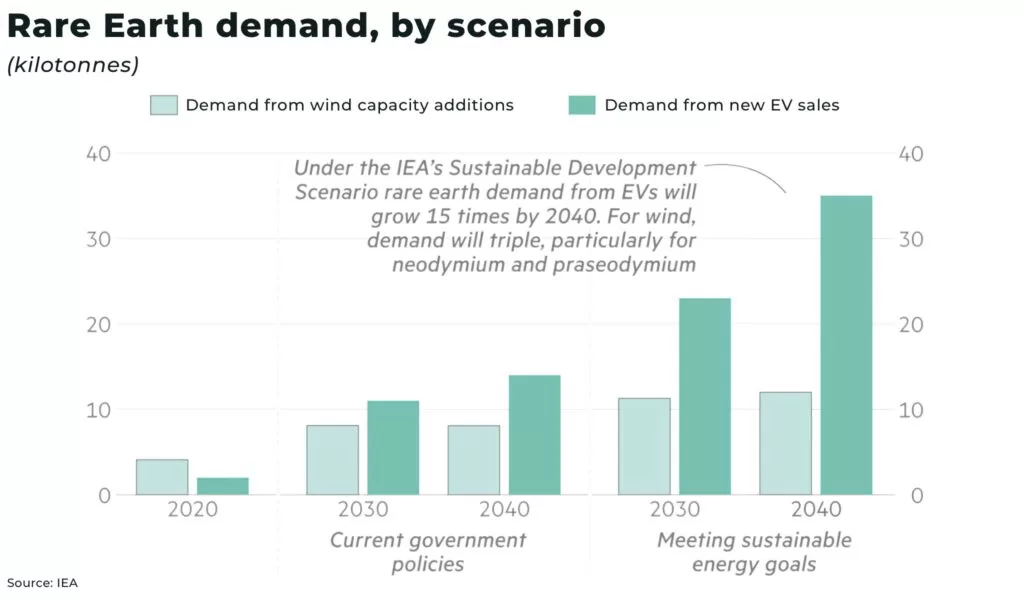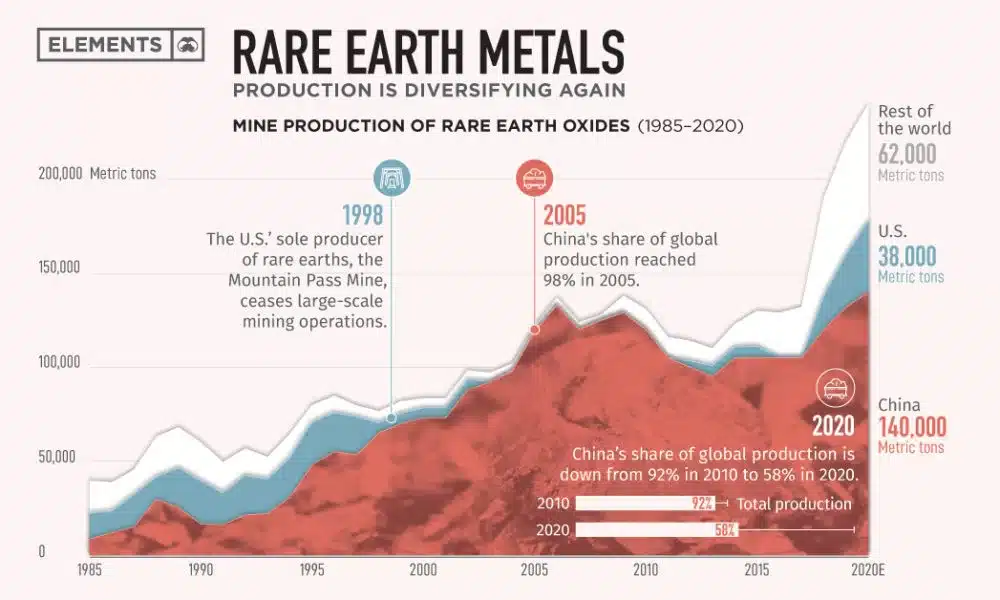Friction from the West is Loosening China’s Grip on Rare Earths Elements
As the world grapples with the urgent need for decarbonization to combat climate change, China’s top position in the production of rare earth elements (REEs) and its growing influence in the carbon credit market have had profound implications for the global energy transition
China currently dominates the market supplying over 80% of the world’s rare earth elements. Considered a monopoly in most political circles, its prominent position has raised concerns among many nations about the vulnerability of their supply chains and the geopolitical implications. But is this tension a sign of possibile future supply limitations that pose a threat to the decarbonized future?
REEs are a set of 17 metallic elements with unique electrical and magnetic properties, playing a crucial role in the mineral supply chain market. Their applications range from magnets powering electric vehicles (EVs) and wind turbines to defense systems using precision missiles, fighter jets, and submarines, energy-efficient lighting systems etc.
All these factors come down to one thing: green energy transition, because:
China leads the production of key materials for EV batteries, refining 68% of the world’s cobalt, 65% of nickel, and 60% of lithium meeting the required grade. Additionally, it holds a significant share of ~ 75% of EV batteries, and the majority of them are manufactured in China.
China maintains its position in the rare earth industry due to its comprehensive control over the entire production chain and a substantial scale in the world economies. China’s advantages extend from mining raw materials to producing high-purity rare earths, facilitated by a cost-effective labor force.
Is this enough to sustain China’s dominance in the long run? It’s indeed a matter of concern and the answer is that there are numerous loopholes in marketing strategies, political scenarios, and supply chain management.
Interdependence of global decarbonization goals and China’s REEs
The concentration of REEs in China raise concerns worldwide. Although, the US Department of Energy once said:
“the US decarbonization goals are reliant on both Chinese firms and the Chinese government”
Yet the current geopolitical scenario is slightly different. The prime issue is that no matter where the REEs are mined, they need to undergo processing in China. This grants China substantial influence over various supply chains. But in this ESG-conscious era, investors, suppliers, and consumers must be more aware of the environmental effects of their purchases.
The extraction of rare earth minerals is a complex process and has raised serious climatic concerns. A study from the Harvard International Review stated,
“Mining to produce one ton of rare earth elements results in nearly 30 pounds of dust, 9,600-12,000 cubic meters of waste gas including substances such as hydrofluoric acid and sulfur dioxide, 75 cubic meters of wastewater, and one ton of radioactive residue—2,000 tons of toxic waste altogether.”
The report also mentioned that the world’s largest rare earth element mine, Bayan-Obo in China, produced over 70,000 tons of radioactive thorium waste which is stored in a tailing pond that has leaked into groundwater.
China, being the prime market for REEs must adopt ways to make large-scale mining more sustainable and greener. Some latest technologies include:
- Electrokinetic method is used by many Chinese companies to improve the leaching process and quantity of the extracted minerals. It’s mostly suitable for heavy REE with high atomic numbers like dysprosium and terbium.
- Biomining is a highly sustainable process that incorporates microbes to do the leaching process. One such species is the cyanobacteria- it produces organic acid to extract the REE from recycled e-waste, ores, and wastewater.
- Agromining – the process incorporates plants that have hyperaccumulation and rapid-growth capacity on REE-rich soil. Researchers say agromining works most efficiently for nickel.
However, all the sustainable alternatives mentioned above are yet to be examined deeply considering their practical values and cost effectiveness.
We can infer that China to remain in the top position in the carbon market and REEs, must operate in socially and environmentally responsible ways. The country further needs to ensure transparent supply chains free from human rights infringement and environmental damage.
READ MORE : China’s CO2 Emissions Up 4% in Q1 2023, Hit a Record High
On the other hand, the West is putting serious efforts to decrease dependence on China for rare earth mineral supply. They are exploring technologies to replace REEs or use fewer REEs.
For example, Tesla recently announced plans for next-generation motors using rare earths-free magnets. There’s a mixed review of this move. While some industry pundits say it would have minimal effect on the market because they believe EVs without rare earth will have a very low success rate. While others consider this to be a revolutionary move. It is further predicted that production of EVs in the coming years won’t experience a slump if they become independent of rare earth minerals. This in turn will directly push the carbon market and mitigate carbon dioxide emissions.
These are just some of the factors responsible for REE’s geopolitical conundrum and have given rise to an important question – does a fair trade agreement exist between China and the West over rare earth elements?
Will Friction from the West Loosen China’s Grip on REEs?
The US and Europe have shaken hands and signed deals without China. President Biden and his allies prioritize technology and green energy, while Global South nations, like India, push for EV adoption to boost energy independence.
One notable collaboration involves US and European rare earth companies processing monazite sands in Utah, followed by shipping rare earth carbonates to Estonia for further refinement.
In recent news, the United States Department of Defense (DoD) granted a $120 million contract to Australia’s Lynas Rare Earths to construct a heavy rare earths separation facility in Texas. Lynas USA LLC, a subsidiary of Lynas Rare Earths Ltd, will own and operate this facility. The objective of the contract is to bolster domestic industrial capacities for heavy rare earth elements (HREEs), involving metals like gadolinium, dysprosium, and ytterbium.
Japan has also fortified its rare earth supply chain by increasing investments in Lynas, securing a steady supply of heavy rare earths. According to UN Comtrade data, Japan has succeeded in this strategic move to decrease its rare earth dependence on China from over 90% to 58% within a decade.
Source: elements.visualcapitalist.com
The graph above showcases China’s share of global production of REE market is expected to go down from 92% in 2010 to 58% in 2020.
Despite the solid efforts put in by the US, Europe, and Japan, China continues to defend its monopoly. It has aggressively expanded its international market by acquiring stakes in some of the largest mining companies like MP Materials (US) and Vital’s Metals (Australia).
China’s tax system and production quota are highly meticulous. It has imposed 13% VAT on magnets, metals, and oxides. Simply put, domestic rare earth product manufacturers have a 13 % cost advantage in the supply chain over foreign competitors. Thus, if countries decide to diversify their rare earth supply chains away from China, it could result in increased costs for those nations.
Will this Geopolitical Tension be a Roadblock to the Green Energy Transition?
A survey conducted by The Oregon Group, explains that 2024 is expected to witness persistent volatility and surged prices in major commodities and rare earth minerals. Contributing factors are:
- supply constraints
- geopolitical tensions
- long-term underinvestment
This economic contraction particularly in the US and China can potentially supress demand and supply, especially in the critical mineral sector. It’s foreseeable that in the current year and beyond, a distinct divergence in critical mineral prices between Western nations and China may not manifest. And this leads one to the conclusion that if geopolitical tensions and inefficient strategic planning persist between the leading economies of the world, then energy transition goals for sustainable low-carbon future are most likely to get hindered.




